The Rise of Streamlined HR: A Paradigm Shift
The traditional HR department, often seen as a bureaucratic bottleneck, is undergoing a dramatic transformation. The future of workplace management lies in streamlining HR processes, leveraging technology, and focusing on employee experience. This shift is driven by several factors, including a competitive talent market, the rise of remote work, and a growing need for data-driven decision-making. Businesses are realizing that a leaner, more efficient HR function is crucial for attracting and retaining top talent, fostering a positive work environment, and ultimately driving business success.
Automation: The Engine of Efficiency
Automation is at the heart of streamlined HR. Repetitive tasks like payroll processing, onboarding paperwork, and benefits administration are being automated, freeing up HR professionals to focus on more strategic initiatives. Software solutions, incorporating AI and machine learning, are handling these tasks with greater speed and accuracy, reducing errors and freeing up valuable time. This automation not only improves efficiency but also enhances employee satisfaction by ensuring timely and accurate processing of their requests and information.
Data-Driven Decisions: Beyond Gut Feelings
Gone are the days of relying on gut feelings in HR decision-making. Today’s streamlined HR functions leverage data analytics to gain valuable insights into employee behavior, performance trends, and workforce planning. By analyzing data from various sources – including performance reviews, employee surveys, and recruitment metrics – HR professionals can make more informed decisions regarding talent acquisition, training and development, and compensation strategies. This data-driven approach leads to more effective and impactful HR initiatives.
Employee Self-Service: Empowering the Workforce
Empowering employees is a key component of streamlined HR. Self-service portals are becoming increasingly common, allowing employees to access information, manage their benefits, request time off, and update their personal details independently. This not only reduces the workload on HR staff but also empowers employees by giving them greater control over their own information and processes. It fosters a sense of autonomy and efficiency, improving overall employee satisfaction.
Focus on Employee Experience: The Human Touch Remains Crucial
While technology plays a significant role in streamlining HR, it’s crucial to remember that HR is ultimately about people. A streamlined HR function shouldn’t sacrifice the human touch. The focus should be on creating a positive employee experience, fostering a culture of inclusivity and belonging, and providing employees with the support they need to thrive. Streamlining HR isn’t about eliminating human interaction; it’s about optimizing it to create a more fulfilling and productive workplace.
Talent Acquisition & Management: A Streamlined Approach
Streamlining HR also significantly impacts talent acquisition and management. Applicant tracking systems (ATS) automate the recruitment process, helping to identify and attract qualified candidates more efficiently. Performance management systems provide tools for tracking employee progress, identifying training needs, and fostering professional development. This integrated approach ensures a smoother and more effective talent lifecycle, from recruitment to retention.
The Future is Integrated: Connecting the Dots
The future of streamlined HR lies in integration. Connecting different HR systems and data sources creates a holistic view of the workforce, enabling more effective decision-making and improved efficiency. This integrated approach allows for a seamless flow of information across different HR functions, minimizing data silos and maximizing the effectiveness of HR initiatives. It provides a unified platform for managing all aspects of the employee lifecycle.
Continuous Improvement: Embracing Change
Streamlining HR is not a one-time project; it’s an ongoing process of continuous improvement. Regularly evaluating HR processes, embracing new technologies, and gathering feedback from employees are crucial for maintaining efficiency and effectiveness. A commitment to continuous improvement ensures that the HR function remains aligned with the evolving needs of the business and its employees, fostering a dynamic and responsive workplace.
The Bottom Line: A Competitive Advantage
In today’s competitive business landscape, a streamlined HR function is no longer a luxury; it’s a necessity. By automating tasks, leveraging data, empowering employees, and focusing on the employee experience, businesses can create a more efficient, productive, and engaging workplace. This, in turn, leads to improved employee retention, increased productivity, and a significant competitive advantage in attracting and retaining top talent. Click here about company hr software






